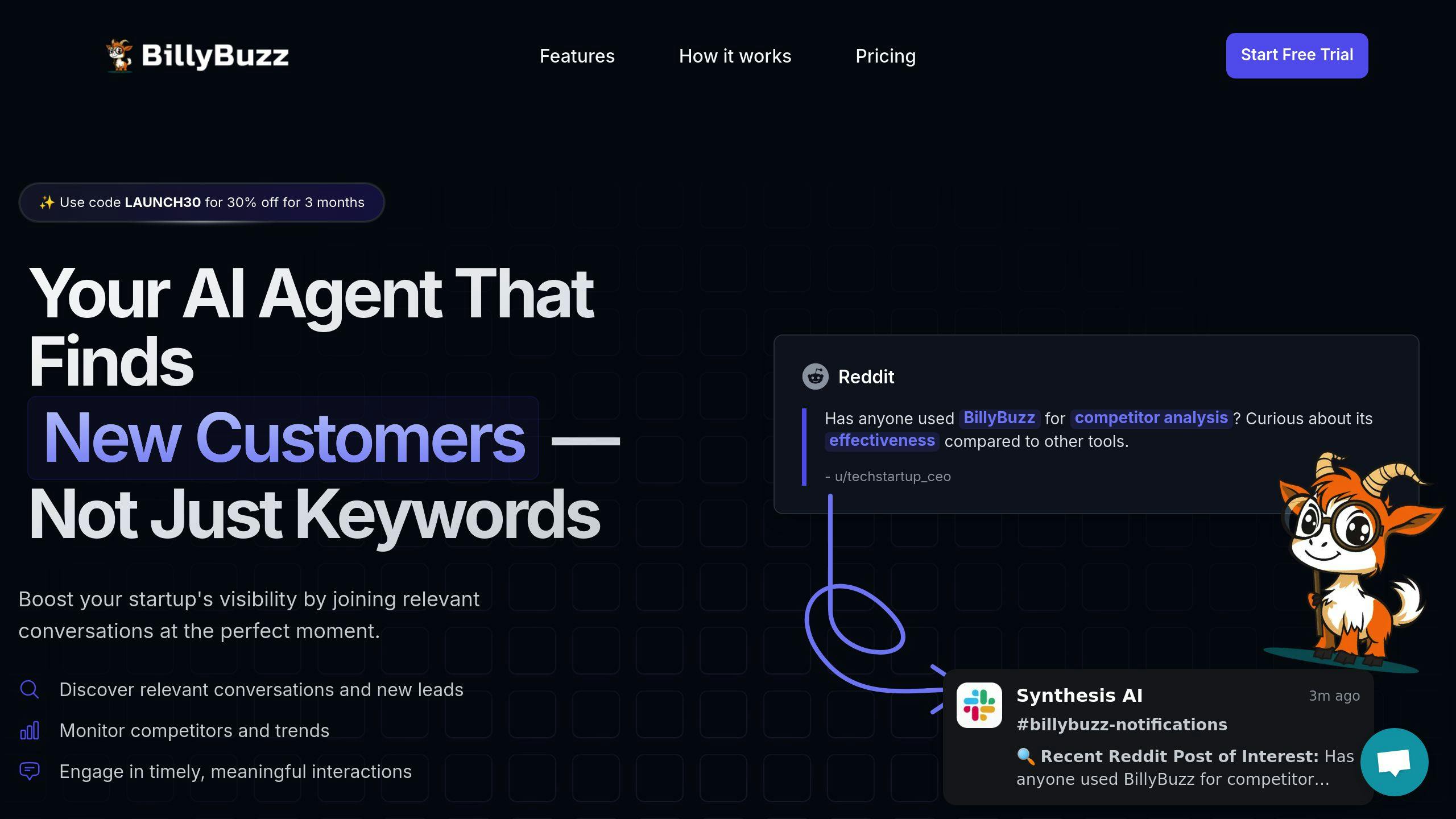
How to Monitor Competitors on Social Media
Monitoring competitors on social media is essential to stay ahead in your industry. Here's how you can benefit:
- Understand Competitor Strategies: Learn what content works for them and why.
- Spot Market Gaps: Identify unmet audience needs to create better content.
- Analyze Engagement: Track likes, shares, and comments to improve your own campaigns.
- Refine Your Approach: Use insights to adjust timing, formats, and messaging.
Tools to Use:
- BillyBuzz: AI-driven tool for tracking mentions and engagement.
- Hootsuite: Great for visual content tracking (videos, memes).
- Brandwatch: Real-time competitor insights.
- Sprout Social: Simple and user-friendly for teams.
Key Steps:
- Choose Competitors & Platforms: Focus on direct and indirect competitors.
- Track Metrics: Engagement, follower growth, content performance, and demographics.
- Use Tools: Set up AI-powered tools to automate monitoring.
- Analyze Data: Look for patterns in content strategy, timing, and audience response.
- Optimize Campaigns: Adjust based on insights to outperform competitors.
Quick Comparison of Tools:
| Tool | Features | Best For |
|---|---|---|
| BillyBuzz | AI insights, keyword tracking | Comprehensive monitoring |
| Hootsuite | Visual content tracking | Small-medium businesses |
| Brandwatch | Real-time analytics | Large organizations |
| Sprout Social | User-friendly dashboard | Team collaboration |
Start monitoring today to refine your marketing strategies and stay competitive.
How to do a social media competitor analysis
Tools for Tracking Competitors on Social Media
AI-powered tools make it easier to keep tabs on competitors, offering insights that help businesses analyze their activities across various platforms.
BillyBuzz: AI-Driven Competitor Monitoring

BillyBuzz leverages AI to highlight the most relevant mentions of your competitors, cutting through the noise on platforms like Reddit and X. It offers three subscription plans:
| Plan | Price | Features |
|---|---|---|
| Starter | $15/mo | Tracks basic subreddits and keywords with daily alerts |
| Growth | $31/mo | Adds AI-powered insights for enhanced monitoring |
| Scale | $79/mo | Offers extensive tracking with faster alerts |
Comparing Hootsuite, Brandwatch, and Sprout Social

Different tools come with different strengths. Here’s a quick breakdown:
| Tool | Key Features | Best For |
|---|---|---|
| Hootsuite | Tracks visual content like videos and memes across platforms | Small to medium businesses |
| Brandwatch | Provides AI-based real-time competitor insights | Large organizations |
| Sprout Social | Simple and user-friendly tracking | Teams looking for ease of use |
Hootsuite’s Listening tool even incorporates visual recognition, making it possible to track brand mentions in videos and memes [1]. Brandwatch offers real-time insights by processing vast amounts of data, while Sprout Social is ideal for teams that prioritize simplicity.
Each tool has its strengths, whether it’s analyzing visual content, processing conversations in real time, or providing straightforward competitor tracking. The best tool for you depends on your goals, budget, and team needs. Once you’ve chosen, set it up properly to start gathering insights.
Steps to Monitor Competitors
Keeping an eye on competitors involves a clear, step-by-step process to gather and analyze key information from social media. Here's how to set up a monitoring strategy that actually helps you stay ahead.
Choosing Competitors and Platforms
Start by identifying your competitors. Look at direct competitors (those offering similar products or services) and indirect competitors (those targeting the same audience but with different offerings). Once you've got your list, focus on tracking metrics that give you a clear picture of their performance and audience behavior:
| Metric Type | What to Track | Why It Matters |
|---|---|---|
| Engagement | Comments, shares, likes | Shows how involved their audience is |
| Growth | Follower trends | Indicates their market reach |
| Content Performance | Post reach, video views | Highlights what resonates with their audience |
| Audience Demographics | Age, location, interests | Helps you understand their audience better |
Configuring Monitoring Tools
Set up tools to track everything from competitor brand names and product lines to campaign hashtags and mentions of their executives. Don't forget to include industry keywords to capture a broader view of their activity. Make sure you're monitoring across all the platforms where they're active so you don’t miss any important moves.
Analyzing Data for Insights
The real value comes from turning raw data into actionable insights. Look for patterns and trends in your competitors' behavior. Here’s what to focus on:
- Content Strategy: What types of posts get the most engagement? Use this to tweak your own content.
- Posting Patterns: When do they post, and how does timing affect engagement?
- Audience Response: What’s the general sentiment? Are there recurring themes in comments and shares?
- Campaign Performance: How well are their promotions doing? This can help you evaluate your own campaigns.
Once you've gathered these insights, use them to sharpen your own marketing approach and stay one step ahead of the competition.
sbb-itb-efb8de3
Using Insights to Improve Marketing Strategies
Once you've gathered insights from competitor analysis, it's time to refine your marketing strategies to address gaps and boost engagement.
Finding Content Gaps
Content gaps are areas competitors may have missed, offering you a chance to stand out. Here's how to spot them and take advantage:
| Content Analysis Area | What to Look For | How to Take Advantage |
|---|---|---|
| Format Types | Limited use of video, live streams, or blogs | Focus on creating content in these underused formats |
| Topic Coverage | Weak or missing coverage of key industry topics | Develop in-depth, well-researched content |
| Audience Behavior | Unanswered questions, engagement trends, or timing patterns | Tailor content to meet these needs and optimize posting schedules |
"AI-powered social listening can transform unstructured data into actionable insights" [1].
After identifying these opportunities, it's time to update your campaigns and engagement strategies to make the most of them.
Adjusting Campaigns and Engagement
Competitor insights can help you fine-tune your approach. Tools like BillyBuzz's AI scoring can play a key role in optimizing your social media efforts. Here's how to put these insights into action:
How to Optimize Campaigns and Engagement:
- Timing: Post when your audience is most active, especially during times your competitors are less visible.
- Content Formats: Focus on formats that are driving competitor success, like video, while exploring underused options.
- Response Strategy: Aim to meet or surpass your competitors' response times to build trust.
- Visual Branding: Analyze what works visually for competitors, but ensure your branding remains distinct.
- Sentiment Analysis: Tools like Brandwatch can help you understand what resonates positively with your audience.
- Hashtag Use: Create unique, effective hashtags based on patterns of competitor success.
Incorporating Monitoring into Your Workflow
Once you've gathered insights, the next step is to make monitoring a regular part of your workflow. This ensures you can consistently track progress and respond to changes effectively.
Scheduling Regular Monitoring
Creating a clear monitoring schedule helps your team gather useful insights without feeling overwhelmed. It also allows you to stay alert to competitor activities and market trends.
| Monitoring Frequency | Focus Areas | Key Actions |
|---|---|---|
| Daily | Competitor posts, engagement | Review new content, check engagement metrics, track responses |
| Weekly | Content trends, performance | Examine top posts, evaluate hashtag performance |
| Monthly | Growth patterns, strategies | Assess follower growth, campaign outcomes, and content shifts |
| Quarterly | In-depth analysis | Explore trends deeply, refine monitoring parameters |
To make this easier, consider using tools like Hootsuite for tracking keywords or Sprinklr for analyzing engagement metrics [1].
Sharing Insights with Teams
Monitoring is only useful when the insights are shared effectively. Keeping all teams informed ensures everyone works toward the same goals. Here’s how you can do it:
- Set up a centralized dashboard for real-time competitor data. Tools like Sprout Social allow you to create custom reports tailored to different teams [4].
- Share insights through weekly marketing updates, customer service performance reviews, and monthly strategy discussions. This keeps everyone aligned and informed.
- Tailor reporting formats to each team's needs. For example, the content team might need detailed metrics on engagement, while executives may prefer broader trend summaries [2][3].
Pro Tip: Automate insight sharing with tools like Brandwatch. This saves time and ensures accurate, timely information delivery [1].
Conclusion: Key Points for Competitor Monitoring
AI-powered competitor monitoring plays a crucial role in staying ahead in social media marketing. By pairing smart analysis with the right tools, businesses can turn insights into actionable strategies that drive real results.
To succeed in competitor monitoring, focus on these two core areas:
- Strategic Implementation: Choose tools that align with your specific goals and set up workflows for regular analysis. This ensures you're consistently tracking competitors and staying agile in response to market shifts.
- Data-Driven Decision Making: Use the insights you gather to shape your strategy. Analyze competitor performance, find content gaps, and tweak your campaigns as needed. Collaboration and sharing insights across your team make this process even stronger.
Using multiple tools often delivers the most thorough results. One tool might be great for basic tracking, while another offers deeper analytics. Combining their strengths gives you a full picture of the competitive landscape.
The real value of competitor monitoring lies in how you use it. By sticking to a regular monitoring schedule and fostering clear communication within your team, you can:
- Spot and act on market opportunities quickly
- Adjust strategies based on competitor moves
- Stay relevant by making informed decisions
- Predict and react to industry trends with confidence
As technology evolves, features like predictive analytics and smarter AI will make it even easier to anticipate competitor actions. By sticking to these monitoring basics while adopting new advancements, businesses can secure a strong position in the ever-changing world of social media.
FAQs
Here are answers to some common questions about monitoring competitors on social media.
How can I track competitors' social media engagement?
Start by identifying up to 5 key competitors relevant to your market. Use tools like Hootsuite or Brandwatch to monitor metrics such as engagement rates and content performance. Pay attention to likes, shares, and audience sentiment to gauge how their audience is responding to their content.
"Hootsuite Listening offers comprehensive tracking across multiple platforms, including social media, news sites, blogs, and forums, providing a complete view of competitor activities" [1].
What’s the best way to track competitors on social media?
Here’s a simple three-step process:
- Identify Competitors and Keywords: Find competitors by researching industry-specific keywords. This will help you narrow down the most relevant players in your space.
- Choose the Right Tools: Use tools like Brandwatch, Hootsuite, or Sprout Social to track their activities. Check out the earlier section for a detailed comparison of these platforms.
- Stick to a Schedule: Set a consistent monitoring schedule to stay updated on their strategies and performance.
| Tool | Best For | Key Features |
|---|---|---|
| Brandwatch | In-depth Analytics | AI-driven insights, sentiment tracking |
| Sprout Social | Team Collaboration | Unified dashboard, scheduling tools |
| Buzzsumo | Content Performance | Trending topics, performance metrics |
